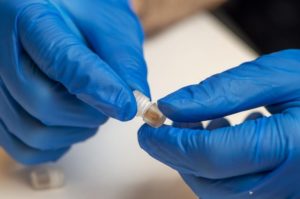Looking back at 2020, we would like to share with you some of the great research that has been published in RSC Advances over the year. We are proud to present a selection of the most popular 2020 nanoscience papers, reviews and HOT articles published so far.
We hope you enjoy reading these articles and as always, all our articles are open access – free to read and accessible to everyone.
| RSC Advances in the news |
Adhesion and bactericidal properties of nanostructured surfaces dependent on bacterial motility
Keisuke Jindai, Takeshi Ito et al. DOI: 10.1039/C9RA08282D
To combat antmicrobial resistance, Takeshi ito and colleagues have been researching natural and artificial instances of nanostructured surfaces – including cicada wings, gecko feet and black silicon – which are bactericidal, with the ability to break the cell membranes of bacteria.
The study was published in February and was covered in a piece published in The Times newspaper.
| 2020 HOT articles |
Over the year, our reviewers and Associate Editors have handpicked articles of particular interest and marked them as HOT. We are very pleased to highlight some outstanding 2020 nanoscience HOT articles:
Versatile magnetic microdiscs for the radio enhancement and mechanical disruption of glioblastoma cancer cells
Selma Leulmi Pichot, Russell Cowburn et al., DOI: 10.1039/D0RA00164C
 The study by Selma Leulmi Pichot (University of Cambridge) and colleagues describes the use of a new type of magnetic microparticle to improve the treatment of glioblastoma multiforme, the most aggressive form of brain cancer.
The study by Selma Leulmi Pichot (University of Cambridge) and colleagues describes the use of a new type of magnetic microparticle to improve the treatment of glioblastoma multiforme, the most aggressive form of brain cancer.
‘Our results demonstrate that we have powerful tools that can efficiently contribute to improve the current treatment of glioblastoma. Moreover, when used as an adjunct to surgery, the magnetic microdiscs have the potential to shorten the course of radiation therapy in countries where access to radiation therapy is scarce.’
Read the interview with Selma Leulmi Pichot about her article here.
More HOT articles
Directly writing flexible temperature sensor with graphene nanoribbons for disposable healthcare devices
Xue Gong, Liqiang Liet al., DOI: 10.1039/D0RA02815K
Read the full HOT article collection
| Most popular 2020 articles |
Reviews
Progress in the functional modification of graphene/graphene oxide: a review
Wang Yu, Luo Jie et al., DOI: 10.1039/D0RA01068E
Developments and applications of nanomaterial-based carbon paste electrodes
Somayeh Tajik, Mohammadreza Shokouhimehr et al., DOI: 10.1039/D0RA03672B
Papers
Identification of preferentially exposed crystal facets by X-ray diffraction
Liping Zhang, Mietek Jaroniec et al., DOI: 10.1039/D0RA00769B
Study of 223Ra uptake mechanism on hydroxyapatite and titanium dioxide nanoparticles as a function of pH
Petra Suchánková, Ján Kozempel et al., DOI: 10.1039/C9RA08953E
The structure and photoelectrochemical activity of Cr-doped PbS thin films grown by chemical bath deposition
Ashour M. Ahmed, Mohamed Shaban et al., DOI: 10.1039/C9RA11042A
The fabrication of a chemical sensor with PANI-TiO2 nanocomposites
Mohammad R. Karim, Mohammed M. Rahman et al., DOI: 10.1039/C9RA09315J
Antibacterial potential of Ni-doped zinc oxide nanostructure: comparatively more effective against Gram-negative bacteria including multi-drug resistant strains
Atanu Naskar, Kwang-sun Kim et al., DOI: 10.1039/C9RA09512H
Investigation of strain and doping on the electronic properties of single layers of C6N6 and C6N8: a first principles study
Asadollah Bafekry, Mohsen Shafieirad et al., DOI: 10.1039/D0RA04463F
Projection method as a probe for multiplexing/demultiplexing of magnetically enriched biological tissues
Mohammad Reza Zamani Kouhpanji and Bethanie J. H. Stadler, DOI: 10.1039/D0RA01574A
PLGA nanoparticle preparations by emulsification and nanoprecipitation techniques: effects of formulation parameters
Karol Yesenia Hernández-Giottonini, Armando Lucero-Acuña et al., DOI: 10.1039/C9RA10857B
Atomic scale study of black phosphorus degradation
Changbae Hyun, Kwang S. Kim et al., DOI: 10.1039/C9RA08029E
Efficient removal of Cu(II) from aqueous systems using enhanced quantum yield nitrogen-doped carbon nanodots
Mohammed Abdullah Issa, Hamid Zentou et al., DOI: 10.1039/D0RA02276D
Continuous syntheses of carbon-supported Pd and Pd@Pt core–shell nanoparticles using a flow-type single-mode microwave reactor
Masato Miyakawa, Masateru Nishioka et al., DOI: 10.1039/C9RA10140C
Hollow Au@TiO2 porous electrospun nanofibers for catalytic applications
Labeesh Kumar, Bhanu Nandan et al., DOI: 10.1039/C9RA10487A
Beetle-like droplet-jumping superamphiphobic coatings for enhancing fog collection of sheet arrays
Xikui Wang, Youfa Zhang et al., DOI: 10.1039/C9RA09329J
Sorption capacity of seaweed-like sodium titanate mats for Co2+ removal
Yoshifumi Kondo, Tohru Sekino et al., DOI: 10.1039/D0RA06662A
Hybrid red blood cell membrane coated porous silicon nanoparticles functionalized with cancer antigen induce depletion of T cells
Antti Rahikkala, Hélder A. Santos et al., DOI: 10.1039/D0RA05900E
 Submit to RSC Advances today! Check out our author guidelines for information on our article types or find out more about the advantages of publishing in a Royal Society of Chemistry journal.
Submit to RSC Advances today! Check out our author guidelines for information on our article types or find out more about the advantages of publishing in a Royal Society of Chemistry journal.
Keep up to date with our latest HOT articles, Reviews, Collections & more by following us on Twitter. You can also keep informed by signing up to our E-Alerts.

























